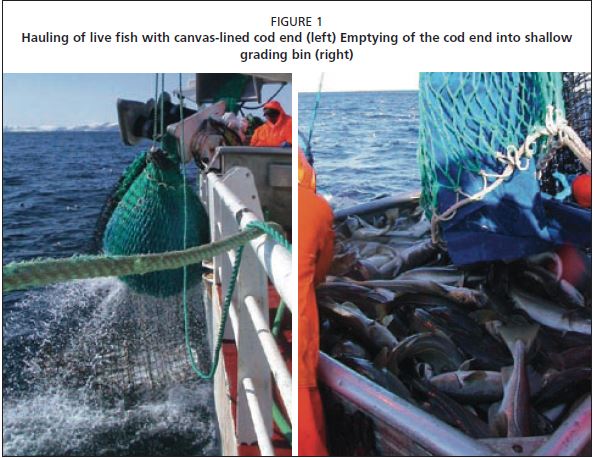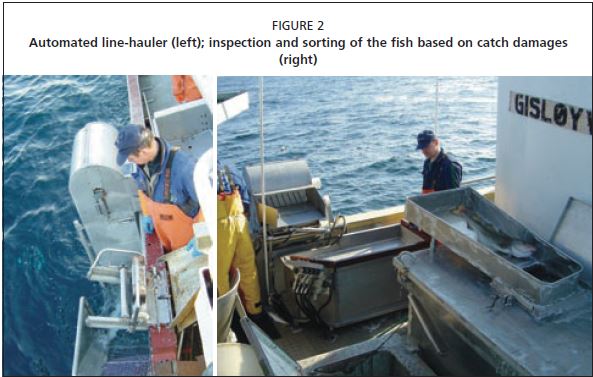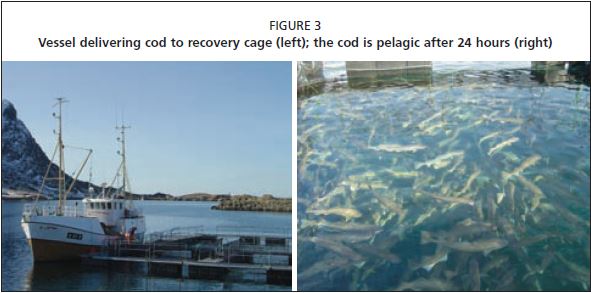DESCRIPTION OF THE FISHING ACTIVITY
The capture of cod for the purpose of keeping it live is a tradition in Norway. As early as the 1880s, Norwegian sailing vessels went to Iceland to fish for cod using long-lines. On the last two weeks of each trip, they stored the cod alive in a specially designed section of the vessel’s hull. Water was exchanged through perforations in the hull, but only when the vessel was moving. The reward, however, could be substantial as live cod could achieve a price one hundred times higher than salted cod.
Capture-based aquaculture on cod varied in importance during the twentieth century, but it was not until the introduction of cod as an aquaculture species in the mid-1980s that it became important. Over the last three decades, cod CBA has reflected the available quotas for coastal vessels; low quotas leading to high activity and vice versa (see section on “Advantages of CBA of cod”).
Gear
Seine nets (such as Danish seine and Scottish seine) are by far the most important gear for cod CBA. Since 1990 major improvements have been made, both with regards to gear construction and how the fishery is performed. The pictures in Figure 1 show modifications to the cod-end where a canvas-lining reduces pressure on the fish and hence pressure damages (left). Each bag is emptied into a shallow bin where the cod is graded and sent below to the live-fish holding tanks (right).
The gear is operated as in traditional fisheries, except for the final part of the haul back where the hauling speed is reduced. This is done to reduce stress and allow for air from the gas-bladder to leave the cod. A final grading is performed following the
FIGURE 1
Hauling of live fish with canvas-lined cod end (left) Emptying of the cod end into shallow grading bin (right)

transfer to the holding tank, removing cod with residual gas. Normally all cod is alive when taken onboard. If the grading is done correctly, survival during transportation will be between 97 and 100 percent. Sixty percent of the cod from small coastal long line vessels will survive capture and transport (Figure 2).
Figure 2 shows an automated line-hauler for coastal vessels which brings the fish onboard without the use of a gaffer (left). The fishers evaluate the fish and if the hook is swallowed or if the fish is damaged it is bled and gutted. If it has minor wounds it is transferred alive to the holding tank (right).
FIGURE 2
Automated line-hauler (left); inspection and sorting of the fish based on catch damages (right)

FIGURE 3
Vessel delivering cod to recovery cage (left); the cod is pelagic after 24 hours (right)

Cages and recovery
Upon delivery from the fishing vessel, the cod is lethargic and needs to restore itself physiologically as well as refill the gas bladder. Special cages with a flat and taut bottom are used for this purpose. Normally, 50 percent of the cod will move to the bottom of the cage where they will recover and the swimming bladder will heal. Within 24 hours most of the fish become pelagic and are ready for weaning (Figure 3).
Weaning, feeding and growth
As for most other wild fish species caught at an adult stage, the transition to captivity for the cod can be difficult. It is, however, a species with a wide range of behavioural assets which allow it to adapt to captivity within a few weeks. This is also reflected in the duration of the weaning time. If offered a wet-feed diet (herring, mackerel, capelin, sprat or squid) most of the fish will start eating four weeks after capture. On the other hand, if offered only a commercial dry-feed diet, practically all of the fish will refuse to eat. Recent trials to wean the cod with a semi-moist diet are encouraging and new methods are being developed, including vacuum-soaking of dry feed and the use of attractants and gustatory stimulation. There is an ongoing risk evaluation with regard to potential contamination of diseases through wet feed, in particular marine Viral Haemorrhagic Septicaemia (VHS).
Due to the fact that the cod prefer a diet based on the same food they eat in the wild and that there still are several challenges to be solved before the dry feed will suffice, CBA cod are mainly fed a diet of herring, mackerel, capelin, etc. These are wild-caught fish not suitable for human consumption, but intended for fishmeal production. All catch of these species is regulated with quotas. Depending on the state of the cod at capture, six to eight months of feeding will double the cod’s weight, typically from 2.5 to 5 kilograms. The CBA and the farm-raised cod are slaughtered according to national aquaculture regulations.